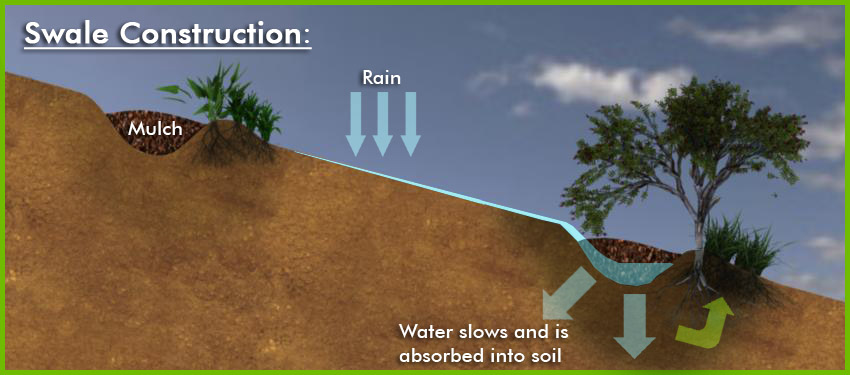Permaculture swales are shallow ditches that follows a contour line. The ditch is then filled with pores soil and plants. The original soil from There is a berms (small dome of dirt) that runs along the downhill side of the swale.
The idea is that water runs down hill, accumulates in the swale and is then held by the plants and organic matter in the ditch itself. The effect is designed to mimic the effects of deep forrest mulch. Once the water is held it slowly seeps into the ground.
Once a swale is complete there are many benefits; prevention of gully creation, collection of eroding soil, slowing of water movement across landscapes, creation of moist riparian micro climates, hydration of the ground water table, and filtration of water within the system.
These benefits can then be used to improve and implement other beneficial aspects of your land;
Companion planting (planning different species of plants that work symbiotically to improve each other's health) and
hugelkultur (when wood is buried under topsoil in the sale of a mound that holds lots of moisture and provides sustained nutrients for plant growth) are just two examples of many potential tools you can combine with swales.
The idea is that water runs down hill, accumulates in the swale and is then held by the plants and organic matter in the ditch itself. The effect is designed to mimic the effects of deep forrest mulch. Once the water is held it slowly seeps into the ground.
Once a swale is complete there are many benefits; prevention of gully creation, collection of eroding soil, slowing of water movement across landscapes, creation of moist riparian micro climates, hydration of the ground water table, and filtration of water within the system.
These benefits can then be used to improve and implement other beneficial aspects of your land;
Companion planting (planning different species of plants that work symbiotically to improve each other's health) and
hugelkultur (when wood is buried under topsoil in the sale of a mound that holds lots of moisture and provides sustained nutrients for plant growth) are just two examples of many potential tools you can combine with swales.
Swale Implementation
How to build a simple tool that will allow you to keep you swale on a contour line.
Sources
https://www.openpermaculture.com/magazine/six-steps-building-swale
http://water.epa.gov/polwaste/npdes/swbmp/Grassed-Swales.cfm
http://permaculture-and-sanity.com/pcarticles/permaculture-earthworks-and-swales.php
https://www.openpermaculture.com/magazine/six-steps-building-swale
http://water.epa.gov/polwaste/npdes/swbmp/Grassed-Swales.cfm
http://permaculture-and-sanity.com/pcarticles/permaculture-earthworks-and-swales.php

